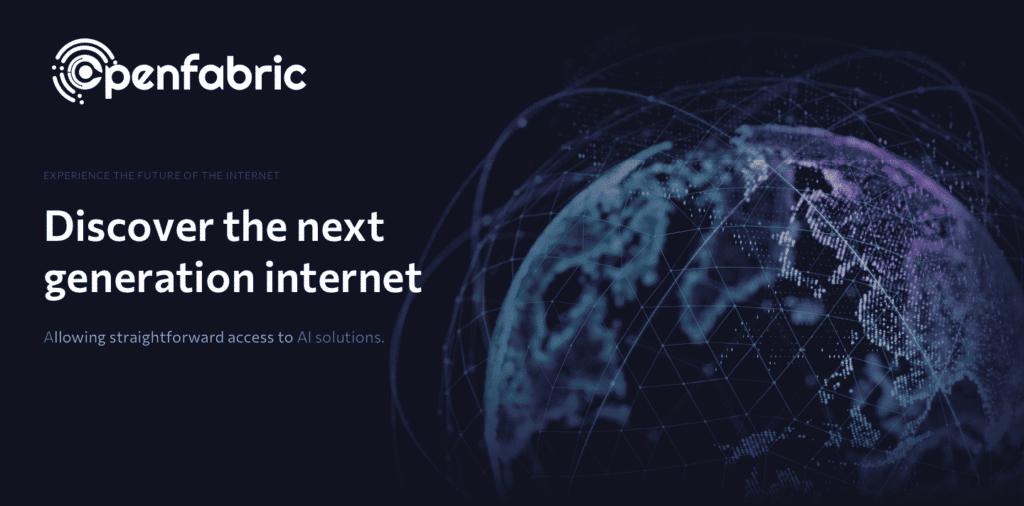
January 15, 2021 14 minutes read
Discover the next generation internet

The community centered around Openfabric becoming the next generation internet continues to grow. This growth is followed by a growing interest of its members in the general ideas of the project. The team has also seen a massive increase in the number and variety of questions addressed to us across all media platforms. Additionally, the feedback we’ve received from the community is highly encouraging, and your messages of support and appreciation makes up an important part of the motivation that makes the development of the Openfabric ecosystem worthwhile.
With this in mind, we would like to take a moment to express our deep gratitude to the enthusiasts who engage with us. This will help in the process of shaping the future of the project.
Based on the manner in which the community has grown in the last months. We predict that this pattern will continue for the nearest future. This will be as Openfabric continues to draw the attention of more visionaries across social media and other digital platforms.
Therefore, there are two goals of the present article.
First, this post serves to provide answers to the most asked questions which have emerged so far.
Second, it will also provide some answers for the newbies who are looking for an introduction to the ecosystem.
So, this text will be showing and answering continual questions which have been posed by the community.
What is Openfabric?
Openfabric represents the support for the Internet of AI and the next generation internet. It is an ecosystem designed to lower the adoption barrier of artificially intelligent systems. It can do this by decreasing the framework demands and technical know-how needed to successfully use AI algorithms.
The Openfabric ecosystem rests on two essential building blocks:
- Openfabric DOS: a blockchain-powered, cryptographically-secure decentralized operating system. This operating system ensures the smooth, secure, and scalable operation of the entire ecosystem;
- Openfabric TEE: a robust, scalable, and secure execution sandbox which allows for the execution of AI.
What is the purpose of Openfabric?
The project aims to offer a platform in which AI innovation can take place at an increased pace. Its purpose is to provide an ecosystem where AI developers will have tools they need to effortlessly deploy their algorithms. Data scientists will be able to compile and upload their dataset. Infrastructure providers will be able to offer the raw computing power to run these algorithms on the appropriate datasets. In this process, Openfabric acts as a decentralized marketplace where participants are rewarded when their Intellectual Property or hardware resources are used to generate new knowledge.
What are the practical applications of Openfabric?
Openfabric has the capability of revolutionizing the current perception around AI. They do this by moving algorithms outside of the academic environment and applying them to real-world problems. The platform also has many practical applications across all areas in which Artificial Intelligence is involved.
For instance, Openfabric could provide the key to performing machine learning algorithms on sensitive datasets. Running the algorithms inside of a trusted execution environment guarantees that no one is able to access the data while it is being processed. This has tremendous potential to tackle our most pressing matters by extracting patterns out of confidential datasets. This can be done efficiently without compromising the privacy of the data.
Openfabric also facilitates the use of more common AI solutions (image and text classification, natural language processing, etc) in an attempt to democratize access to such applications.
How are you connected to next generation internet of AI?
Our capability to create, deploy, and harness various types of AI and machine learning algorithms connects us to the field of Artificial Intelligence. As well as our fondness of the technologies currently being leveraged in this area of Computer Science. Coming from a technical background, we realize that the current procedures for deploying AI programs into real-world scenarios are cumbersome. With the help of the Openfabric platform, we hope to democratize and facilitate access to AI solutions.
Where is the project registered?
Openfabric is registered at https://www.openfabric.ai. This is the main source of information regarding the state of the project. The website contains details about the progress we’re making, along with insight into future perspectives for the platform. You can also read our whitepaper to learn more about the detailed description of the ecosystem. You can also join our communities’ multiple social media platforms.
When was the project registered?
The initial idea behind Openfabric started at the beginning of 2019. We began by considering what it would be like if AI were to be made more open to the public. We also speculated about what sorts of benefits this approach could bring to society at large. Ever since that day, we’ve been making steady progress towards putting this idea into practice.
What are the competitive advantages of Openfabric?
Openfabric leverages the power of ontology models. As the next generation internet which allow for the chaining of AI algorithms into complex flows and pipelines. This feature is not present in any of the other projects that share some similarities with Openfabric. Additionally, the economic model proposed by Openfabric is robust. It incentivizes algorithm developers to reuse the innovations of their peers and to create even more complex solutions.
This property ensures that going forward, the algorithms deployed in the Openfabric ecosystem will be some of the most useful, creative, and innovative AI artifacts ever conceived.
Furthermore, the technologies we employ in the creation of this platform are on the bleeding edge. Whether it be cryptography, trusted execution environments, decentralization, or blockchain. In the end, we ensure that Openfabric platform cannot be replicated. Replication of the Openfabric platform into a spinoff would be a difficult and time-consuming process.
Is it available globally?
In our view, the next generation internet innovations like the Openfabric ecosystem are not — and should not be — restricted to any one geographical area. Therefore, we adopted a decision to make Openfabric globally available, from the very initial stages of the project.
Is it blockchain-based?
Openfabric relies on blockchain technology to offer participants in the ecosystem a shared and unforgeable source of truth. As an immutable ledger technology, blockchain is suitable for maintaining the state of the ecosystem. In this sense, Openfabric is based on blockchain but it is not tied to a particular implementation of blockchain technology. Although the project is blockchain-based, it should also at the same time be blockchain-agnostic.
Who is your target audience?
Openfabric is a platform centered around multiple stakeholders. Its audience is composed of:
- AI innovators who want to monetize their algorithms
- Dataset providers who compile and upload their datasets and are then rewarded each time their data is used.
- Infrastructure providers who offer computing power, apply the algorithms on the datasets and obtain results.
- Service consumer, who combines AI and data and then prompts the infrastructure providers to run them in order to obtain new results and knowledge.
Our platform is also directed at companies and enterprises that want to extract new insights from their data by utilizing Openfabric as a platform which offers AI as a service.
What social media channels do you have?
Telegram: @OpenFabricAI
Twitter: @openfabricai
Facebook: Facebook page
LinkedIn: Linkedin page
Do you have a roadmap for the near future?
Our website contains a dedicated section for following the roadmap of the Openfabric project. Be sure to check it out at Openfabric to see our current status, as well as the direction in which we are heading.
Does Openfabric deal with any government projects?
The Openfabric platform is not the result of a governmental initiative of any state. Consequently, the end-product of this project will be globally available. The project has not received any funding or incentives from government entities.
Why should I invest in Openfabric?
Openfabric is a project that is going to tap into a previously-unexplored reserve (that of general applicability artificial intelligence algorithms and datasets). It will also provide an ecosystem in which such intellectual property can be monetized.
As you are probably already aware, the current state of affairs is that AI developers cannot join a platform that enables them to make a profit from their work. As such, their algorithms are mostly showcased, but never put into practice, even though these programs are valuable. The situation is similar in the case of dataset creation, in which there exists no actual incentive to create and monetize such artifacts. At the same time, everyone is aware that an AI algorithm is useless if the data it trains on is poorly constructed.
Openfabric is here to create a market for these resources and turn them into a commodity. That is why investing in our dream as the next generation internet is the best method for tapping into the AI resource. The team behind the project is composed of highly skilled programmers who are currently hard at work on implementing the concept.
The innovations in Openfabric are being scientifically validated. As a matter of fact, we have also published some papers in scientific journals (the links to which you can find in the roadmap on our site). As the society of tomorrow will most certainly incorporate Artificially Intelligent Agents and programs, the market we are now opening is going to continue to increase in value and volume. For all the reasons mentioned above, Openfabric is a lucrative venture opportunity with a large return on investment.
What progress has Openfabric made so far?
Since its inception in 2019, Openfabric has been making steady progress. The team has identified the main constraints faced by the AI systems and investigated methods to overcome them. The next step was to identify the main stakeholders in the platform. Then, set up the economic model and incentivization mechanism. The team has also released a whitepaper, and is currently in the process of validating the scientific value of the Openfabric platform.
At this point, we have published research papers in scientific journals. We will also continue to release papers regarding various aspects of the ecosystem, in order to achieve the certainty that the building blocks of the Openfabric ecosystem are scientifically sound.
Do you have a whitepaper?
The Openfabric team has released a whitepaper which describes the main architectural components of the platform. It also contains the main innovations that will ensure the successful evolution of the project. The document is an engaging and informative read, and you can find it at the following URL: whitepaper
Where can I find the project’s technical info?
The project’s technical complexity is described in the whitepaper. The paper describes the major technologies that are integrated into the ecosystem, what their scope is, and how the stakeholders can use them to interact with the platform. It also presents the innovations that go beyond mere technological novelty. We strongly encourage you to read it.
What licenses does the project use?
As the next generation internet, this project is going to be open-source. This is to ensure that anyone can see the implementation of our solution. A transparent, open-source implementation of the Openfabric ecosystem is an approach which will help users to gain trust in the ecosystem in which they are participating.
Does participating in the Openfabric ecosystem require specialized hardware?
The platform accommodates multiple types of stakeholders. The only ones concerned with hardware setups are the infrastructure providers. So, to take part in the Openfabric ecosystem, one is not required to provide hardware equipment.
As for the infrastructure providers, at the time of this writing, the only requirement is for the case that they want to process sensitive data. In this case, they must have hardware that provides access to a Trusted Execution Environment (e.g. Intel SGX).
How does the platform incentivize innovators?
One of the stakeholders on the platform is the AI innovator. This is an actor who deploys AI/machine learning algorithms. The contribution of AI innovators is rewarded by the community each time that the algorithm is executed. Additionally, the algorithm can be incorporated by other innovators into their solutions. The innovators will also be rewarded this way.
Further information on the subject of incentivization and the Openfabric economic model can be found in a medium post dedicated to the topic, as well as in our whitepaper.
Do the miners specialize in providing hash rate?
In the Openfabric platform, a node is regarded as being more than a simple miner specialized in providing hash rate. The node can take part in offering multiple services to the network. Services such as the capability for searching for available algorithms, datasets, and infrastructure. It can also take part in storing parts of the ontology that is used to classify algorithms and their inputs and outputs, or even store part of the ratings for the services that are offered on the platform.
Therefore, a node in the platform is not only responsible for maintaining the state of the Distributed Ledger. Additionally, the node can provide execution services for the AI algorithms, and the owner of the node will be rewarded for executing the algorithm.
Who is the team behind the project?
The team behind the Openfabric project is a passionate group of experts and enthusiasts. They dedicate their attention and interest to the emerging field of decentralized systems and the fields of machine learning and Artificial Intelligence. They are highly technically-focused and all come from a computer science background. Having worked extensively in the relatively new domain of blockchain technology, as well as in the area of machine learning algorithms.
What are the functions of Openfabric?
Openfabric is a platform that aims to foster AI innovation at an unprecedented scale. To achieve being the next generation internet, the Openfabric project is conceived as a decentralized free market. In this market, algorithms and datasets are deployed. Some of the functions of the ecosystem are:
- deploying algorithms and datasets
- ensuring interoperability of AI algorithms by leveraging ontologies
- mimicking evolutionary forces with the help of rating mechanisms that promote valuable assets
- offering access to decentralized execution environments
- offering AI execution as a service for enterprises
Is there an SDK for developers?
The Openfabric platform will incorporate a Software Development Kit. This will be used to facilitate the creation and deployment of algorithms and datasets. The SDK will also provide functionality for programmatic interaction with the network, algorithm, and dataset upload. However, the most interesting feature available in the SDK will be the ability to use the algorithms of AI innovators just like you would when importing libraries in a programming language. For the time being, the SDK is not yet fully materialized.
Why go for a decentralized approach?
Openfabric was designed with the key feature of decentralization in mind. Decentralized applications have multiple desirable properties:
- First, they provide a greater level of security and trustworthiness than their centralized counterparts do This is due to the fact that information is stored with multiple stakeholders. So, tampering with the ecosystem requires an unfeasible amount of resources
- Secondly, a decentralized system is more adaptable, flexible, and easier to scale up than a centralized system is. The components of the ecosystem are not concentrated in the hand of a single provider. As a matter of fact, anyone will be able to contribute to the network by hosting some of its features via setting up a node to take part in the network.
- Last but not least, a decentralized approach avoids the single point of failure issue that can serve to temporarily hinder even the most resourceful of companies.
Will Openfabric run on a proprietary blockchain?
Currently, there are no plans to launch Openfabric on a proprietary blockchain. We believe that this would pose a limitation to the whole architecture.
In our vision, Openfabric should be able to operate on multiple blockchain technologies in order to reach a broader audience. Which is why, as the next generation internet, the aim is to design Openfabric to be blockchain-agnostic.
What is the purpose of the blockchain in the Openfabric architecture?
Being an immutable ledger technology, the blockchain is suitable for recording events that happen in the ecosystem. In this aspect, the blockchain can be leveraged to fulfill multiple purposes.
For one thing, it will serve as an immutable recorder of monetary transactions. Although the actual transactions might be carried out through side-channels, their completion will be recorded on the blockchain to serve as proof.
Another usage of the blockchain is as a means for providing access control to the services in the network. For example, a service consumer can be granted access to the execution of a machine learning algorithm for a specified period, or a given number of trials.
Another valid way of using blockchain is to hold the records of the algorithm rating system on the decentralized ledger.
What is the revenue model?
Taking into consideration the four stakeholders who will interact on the Openfabric platform, the ways in which they will benefit from using the ecosystem are the following:
- The AI innovators create intelligent algorithms that the community can use to solve their particular problems. They will be rewarded for their algorithms on a per-execution basis.
- The data providers compile datasets and upload them to the Openfabric platform. Those datasets will then be used by interested actors on the platform in order to train their algorithms or extract information. The effort of the data providers will be rewarded each time their datasets are utilized.
- The service consumers choose AI algorithms and/or datasets and delegate their execution to the Openfabric network in order to gain new insights and extract information out of data. In exchange, they pay for the services they have used.
- Infrastructure providers form the backbone of the Openfabric ecosystem. They rent their hardware so that others can execute algorithms. In exchange for their services, the infrastructure providers will be rewarded with tokens on a per-execution basis.
This is a comprehensive set of questions that have been repeatedly asked by members of the community. We will continue to keep this list updated as more questions are raised, and as the project progresses. This will serve as a suitable introduction to Openfabric, but a detailed description of the project can be found in the whitepaper. Be sure to keep up-to-date with the evolution of the ecosystem by subscribing to the newsletter on the website and by interacting with us on our social platforms! With your contribution, we can shape the future of the AI landscape.

